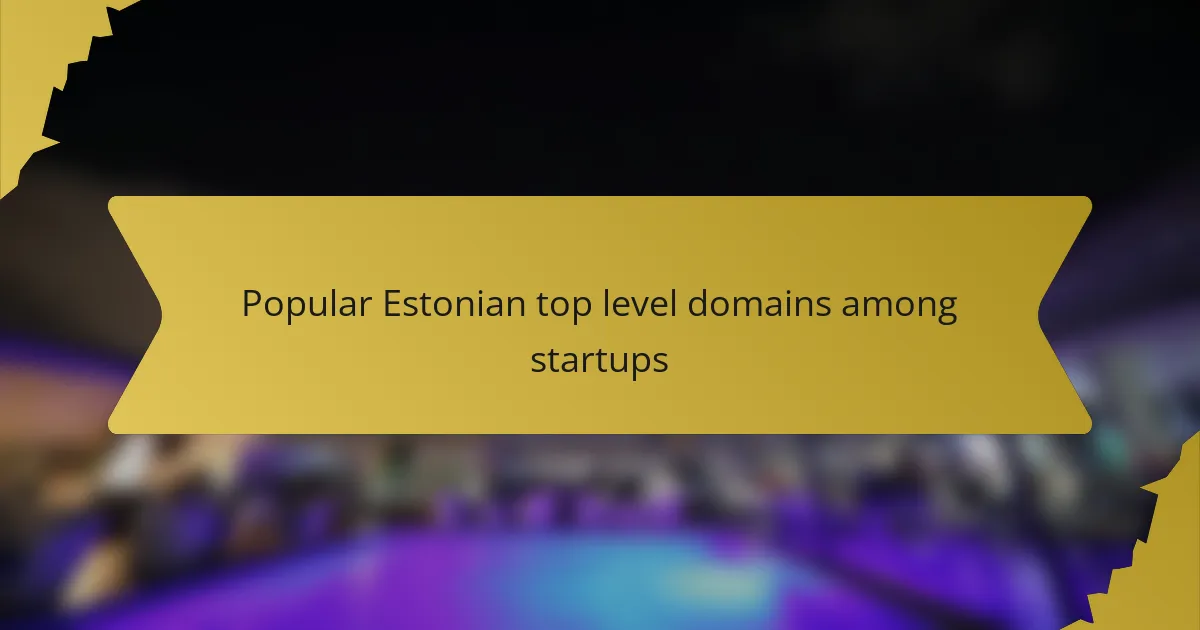In Estonia, startups often opt for the .ee, .com.ee, and .org.ee top-level domains (TLDs) to establish their online identity. These domains not only reflect brand alignment and target audience but also play a crucial role in enhancing credibility and visibility in the digital space. By choosing the appropriate TLD, startups can leverage local trust and improve their search engine rankings, ultimately supporting their growth in the competitive Estonian market.

Which Estonian top level domains are most popular among startups?
Startups in Estonia commonly favor the .ee, .com.ee, and .org.ee top-level domains (TLDs) for their online presence. Each domain serves different purposes and can impact branding, credibility, and visibility in the digital landscape.
.ee domain popularity
The .ee domain is the most widely used TLD among Estonian startups, reflecting national identity and local presence. This domain is particularly favored by businesses aiming to establish credibility within Estonia, as it signals a commitment to the local market.
Startups often choose .ee for its straightforward association with Estonia, making it easier for local customers to recognize and trust the brand. Additionally, having a .ee domain can enhance search engine optimization (SEO) for local searches.
.com.ee domain usage
The .com.ee domain is popular among startups that want to convey a commercial aspect while still maintaining a local touch. This TLD is often used by businesses that operate in both local and international markets, providing flexibility in branding.
Startups may opt for .com.ee to appeal to a broader audience while still being rooted in Estonia. It can be particularly useful for e-commerce platforms and service providers looking to attract both local and international customers.
.org.ee domain adoption
The .org.ee domain is primarily adopted by non-profit organizations, community initiatives, and educational institutions in Estonia. This TLD is associated with non-commercial entities, making it suitable for startups focused on social impact or community service.
Choosing a .org.ee domain can help startups emphasize their mission-driven approach, attracting supporters and volunteers. It is essential for these organizations to ensure that their branding clearly communicates their purpose to avoid confusion with commercial entities.

How do Estonian startups choose their top level domains?
Estonian startups typically choose their top level domains (TLDs) based on factors such as brand alignment, target audience, and search engine optimization (SEO) implications. The right TLD can enhance a startup’s online presence and credibility while also catering to specific market needs.
Brand alignment considerations
When selecting a TLD, startups should ensure it aligns with their brand identity. A domain like .ee can signal a local presence, appealing to Estonian customers, while .com may suggest a broader international reach. Startups should consider how their chosen TLD reflects their mission and values.
Additionally, startups should avoid TLDs that may confuse customers or dilute their brand message. For instance, using a less common TLD might create uncertainty about the legitimacy of the business. Consistency in branding across all platforms, including the TLD, is crucial for building trust.
Target audience relevance
Understanding the target audience is essential when selecting a TLD. For Estonian startups, using a local TLD like .ee can enhance credibility among local consumers who prefer to support domestic businesses. Conversely, startups targeting a global market might opt for .com or .net to appeal to a wider audience.
Startups should also consider the demographics and preferences of their audience. For example, tech-savvy consumers may be more accepting of newer TLDs like .tech, while traditional customers might prefer established options. Tailoring the TLD to audience expectations can improve engagement and conversion rates.
SEO implications
The choice of TLD can impact a startup’s search engine optimization (SEO) strategy. While Google treats all TLDs equally in terms of ranking, local TLDs like .ee can help improve visibility in local search results. This is particularly beneficial for startups focusing on the Estonian market.
Startups should also be aware of the potential for keyword-rich domains to enhance SEO. A TLD that includes relevant keywords can improve search rankings, but it’s essential to balance this with brand alignment. Avoiding overly complex or lengthy domain names is advisable, as simplicity often leads to better user experience and memorability.

What are the benefits of using Estonian top level domains?
Using Estonian top level domains (TLDs) offers startups several advantages, including enhanced local trust, improved search engine visibility, and access to regional resources. These benefits can significantly impact a startup’s growth and market presence in Estonia.
Local trust and credibility
Estonian TLDs, such as .ee, signal to consumers that a business is local, fostering trust and credibility. Customers are often more inclined to engage with companies that have a familiar domain, as it suggests a commitment to the local market.
Startups can leverage this trust by ensuring their domain reflects their Estonian identity. This can be particularly effective in sectors like e-commerce, where local customer confidence is crucial for conversion rates.
Improved local SEO rankings
Utilizing an Estonian TLD can enhance a startup’s local search engine optimization (SEO) efforts. Search engines often prioritize local domains in search results, making it easier for Estonian consumers to find relevant businesses.
To maximize SEO benefits, startups should combine their TLD with localized content and keywords. This strategy can lead to higher visibility in search results, potentially increasing website traffic and customer engagement.
Access to local resources
Startups with Estonian TLDs can tap into various local resources, including government support programs, funding opportunities, and networking events tailored for Estonian businesses. These resources can provide valuable assistance in navigating the local market.
Engaging with local business communities and organizations can further enhance a startup’s visibility and connections. This can lead to partnerships and collaborations that are essential for growth in the competitive Estonian landscape.

What are the challenges of using Estonian top level domains?
Using Estonian top level domains (TLDs) presents several challenges, particularly for startups aiming for broader international reach. These challenges include limited recognition outside Estonia and potential language barriers that may affect user engagement and brand perception.
Limited international recognition
Estonian TLDs, such as .ee, may not be widely recognized by global audiences. This can lead to trust issues, as users often prefer domains that are familiar and associated with established brands. Startups may find it harder to compete with businesses using more recognized TLDs like .com or .org.
To mitigate this, startups should consider pairing their Estonian TLD with a more recognizable domain. For instance, using a .com version alongside the .ee domain can help build credibility while retaining local identity.
Potential language barriers
Language can pose significant challenges when using Estonian TLDs, especially for startups targeting non-Estonian speaking markets. Websites primarily in Estonian may alienate potential customers who do not speak the language, limiting market reach.
Startups should ensure their websites are multilingual or at least provide essential information in English or other relevant languages. This approach can enhance user experience and broaden audience engagement, making it easier to connect with international clients.

What criteria should startups consider when selecting a top level domain?
Startups should focus on domain availability, brand protection, and relevance to their business when selecting a top level domain (TLD). These factors can significantly influence online visibility, credibility, and legal security.
Domain availability
Domain availability is crucial for startups as it determines whether a desired TLD is accessible for registration. Startups should check multiple TLDs, including .ee for Estonia, to find an option that aligns with their brand and is not already taken.
Using domain registration services can simplify this process, allowing startups to search for available names across various TLDs simultaneously. If the preferred domain is unavailable, consider slight variations or alternative TLDs that still resonate with the target audience.
Brand protection strategies
Implementing brand protection strategies is essential for startups to safeguard their online identity. This includes registering multiple TLDs related to the brand to prevent competitors from acquiring similar domains that could confuse customers.
Startups should also monitor domain registrations regularly and consider legal measures, such as trademarks, to protect their brand. Establishing a clear policy for domain management can help avoid potential conflicts and ensure consistent branding across different platforms.

How do Estonian top level domains compare to other regional domains?
Estonian top level domains (TLDs) are increasingly popular among startups, offering unique advantages compared to other regional domains. They provide a local identity, which can enhance trust and recognition in the Estonian market while also being competitive with TLDs from neighboring countries.
Popularity of .ee among startups
The .ee domain is the most widely used TLD in Estonia, particularly favored by startups looking to establish a local presence. This domain is recognized for its reliability and is often associated with businesses that are serious about their operations in Estonia.
Startups choosing .ee benefit from a straightforward registration process, which typically requires minimal documentation. This accessibility encourages new businesses to secure their online identity quickly.
Alternative TLDs for Estonian startups
While .ee is dominant, other TLDs like .com and .net are also popular among Estonian startups, especially those aiming for an international audience. These domains can help businesses appeal to a broader market beyond Estonia.
Choosing an alternative TLD may be beneficial for startups that plan to expand globally. However, they should consider the potential loss of local credibility that might come with not using a .ee domain.
Benefits of using local TLDs
Using local TLDs like .ee can significantly enhance a startup’s visibility within Estonia. Local domains often rank better in search results for Estonian users, which can lead to increased traffic and customer engagement.
Additionally, local TLDs can foster trust among consumers who prefer to support domestic businesses. This can be particularly advantageous for startups in sectors like e-commerce, where local trust is crucial for success.
Considerations when choosing a TLD
When selecting a TLD, startups should weigh factors such as target audience, brand identity, and long-term goals. A .ee domain may be ideal for those focusing on the Estonian market, while .com could be better for those with international aspirations.
Startups should also be aware of the regulatory requirements for different TLDs. For instance, .ee domains may require proof of local presence, which can be a barrier for some international startups.
